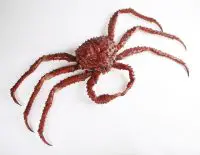Let’s take a look at some of the most interesting Alaskan king crab facts. Alaskan king crab (Paralithodes camtschaticus) is the largest of all king crabs. It is the most sought after king crab by fisheries.
Alaskan King Crab Facts
It has a dark reddish-brown color called burgundy. However, since it turns red after cooking, it is also named as red king crab. It has five pairs of gills for respiration. The abdomens of these crabs are shaped like a fan and they are tucked at the back of the crab’s shell.
The width of its carapace is about 28 centimeters. Its leg span measures 5.8 feet in length and it weighs around 28 pounds. In size, females are smaller than the males.
Mating occurs in early spring. For breeding, adult crabs go toward the shallow waters.
On average, alaskan king crabs stay at water temperature of 38 to 42 °F. Unlike the adult king crabs, its larvae prefer to stay in shallow waters to feed. After 2 years, the young crabs dive down to a depth of up to 164 feet. As they mature, they tend to go down deeper still, more than 656 feet.
crabs stay at water temperature of 38 to 42 °F. Unlike the adult king crabs, its larvae prefer to stay in shallow waters to feed. After 2 years, the young crabs dive down to a depth of up to 164 feet. As they mature, they tend to go down deeper still, more than 656 feet.
For hatching eggs, the females tend to stay at a warmer temperature of 4°C while males remain in colder waters.
It is distributed across the Bering Sea of the Pacific Ocean as well as waters around Alaska.
It inhabits sandy bottoms of the ocean.
They are omnivorous creatures and tend to eat a wide variety of plants and animals. They also scavenge carrion.
The predators for the red king crab are aquatic mammals, octopuses and fish. Yellowfin sole, Pacific cod, sea otters and halibut are the common predators. Red king crabs are also cannibalistic and eat each other.
Other Names: Red King crab, Kamchatka crab





